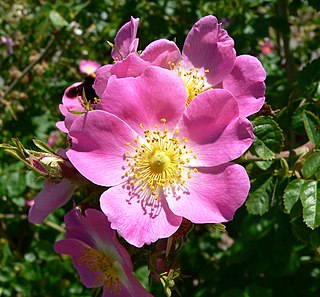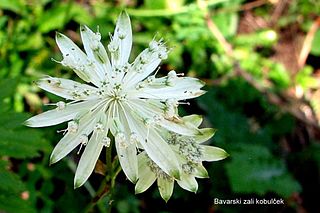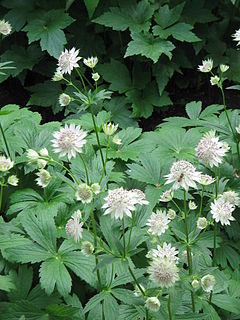This page is based on this
Wikipedia article Text is available under the
CC BY-SA 4.0 license; additional terms may apply.
Images, videos and audio are available under their respective licenses.

A rose is a woody perennial flowering plant of the genus Rosa, in the family Rosaceae, or the flower it bears. There are over three hundred species and thousands of cultivars. They form a group of plants that can be erect shrubs, climbing, or trailing, with stems that are often armed with sharp prickles. Flowers vary in size and shape and are usually large and showy, in colours ranging from white through yellows and reds. Most species are native to Asia, with smaller numbers native to Europe, North America, and northwestern Africa. Species, cultivars and hybrids are all widely grown for their beauty and often are fragrant. Roses have acquired cultural significance in many societies. Rose plants range in size from compact, miniature roses, to climbers that can reach seven meters in height. Different species hybridize easily, and this has been used in the development of the wide range of garden roses.

An inflorescence is a group or cluster of flowers arranged on a stem that is composed of a main branch or a complicated arrangement of branches. Morphologically, it is the modified part of the shoot of seed plants where flowers are formed. The modifications can involve the length and the nature of the internodes and the phyllotaxis, as well as variations in the proportions, compressions, swellings, adnations, connations and reduction of main and secondary axes.
Inflorescence can also be defined as the reproductive portion of a plant that bears a cluster of flowers in a specific pattern.

Dianthus caryophyllus, the carnation or clove pink, is a species of Dianthus. It is probably native to the Mediterranean region but its exact range is unknown due to extensive cultivation for the last 2,000 years. Carnation cultivars with no fragrance are often used by men as boutonnieres or "button holes."

Saint John's Eve, starting at sunset on 23 June, is the eve of celebration before the Feast Day of Saint John the Baptist. The Gospel of Luke states that John was born six months before Jesus; therefore, the feast of John the Baptist was fixed on 24 June, six months before Christmas according to the old Roman calculation. This feast day is one of the very few saints' days which commemorates the anniversary of the birth, rather than the death, of the saint being honored.

Aegopodium podagraria is a perennial plant in the carrot family (Apiaceae) that grows in shady places. The name "ground elder" comes from the superficial similarity of its leaves and flowers to those of elder (Sambucus), which is unrelated. It is the type species of the genus Aegopodium. This species is native to Eurasia, and has been introduced around the world as an ornamental plant, where it occasionally poses an ecological threat as an invasive exotic plant.

Angelic acid is a monocarboxylic unsaturated organic acid. It is mostly found in the plants of the family Apiaceae. German pharmacist Ludwig Andreas Buchner isolated angelic acid in 1842 from the roots of garden angelica which gave the acid its name. Angelic acid is a volatile solid with a biting taste and pungent sour odor. It is the cis isomer of 2-methyl-2-butenoic acid, which easily converts to the trans isomer, tiglic acid, upon heating or reaction with inorganic acids. The reverse transformation occurs much less readily. The salts and esters of angelic acid are called angelates. Angelic acid esters are the active components of herbal medicine used against a wide range of various health disturbances including pains, fever, gout, heartburn, etc.
The Alpine Botanical Garden “Saussurea” is an alpine botanical garden located at Pavillon du Mont Fréty, first station for the Skyway Monte Bianco cable car, in Courmayeur, Aosta Valley, Italy. It describes itself as Europe's highest botanical garden, at 2173 metres above sea level, and is open daily in the warmer months.

Angelica atropurpurea, known commonly as purplestem angelica, great angelica, American angelica, high angelica, and masterwort, is a species of flowering plant that can be found in moist and swampy woodlands, mostly by riverbanks, in eastern North America. It has been found in eastern Canada and the United States.

Oreina gloriosa is a species of broad-shouldered leaf beetles belonging to the family Chrysomelidae, subfamily Chrysomelinae.

Astrantia minor, the lesser masterwort, is a species of herbaceous plant belonging to the family of Apiaceae.

Agonopterix astrantiae is a moth of the Depressariidae family. It is found in most of Europe, except the Iberian Peninsula, most of the Balkan Peninsula and the Benelux.

Astrantia carniolica, the carnic masterwort or red masterwort, is a species of flowering plant in the family Apiaceae. It has long reddish flowers.

Astrantia bavarica, common name masterwort, is a species of flowering plant in the family Apiaceae, native to Eastern alps. Growing to 30 cm (12 in) tall by 30 cm (12 in) broad, it is an herbaceous perennial, much used in gardens.

Masterwort is a common name for several plants in the Apiaceae family and may refer to:
















